The auto-dimming mirror market is estimated to be valued at USD 2.3 billion in 2025 and is projected to reach USD 3.8 billion by 2035, registering a compound annual growth rate (CAGR) of 5.2% over the forecast period. The market's growth is largely attributed to the increasing demand for advanced driver safety features and enhanced driving comfort in modern vehicles. Auto-dimming mirrors, which automatically adjust to changing light conditions, are becoming increasingly popular in both consumer and commercial vehicles.
This growth is driven by consumer preference for advanced safety features that reduce glare from headlights and increase visibility, especially during nighttime driving. The adoption of auto-dimming mirrors is expected to gain further momentum as safety regulations become increasingly stringent and manufacturers strive to provide a more comfortable driving experience. With a growing focus on reducing accidents and enhancing road safety, auto-dimming mirrors are now seen as a key component in many premium and mid-range vehicles. As the global automotive industry continues to innovate and shift toward more intelligent, driver-friendly solutions, the auto-dimming mirror market is expected to experience significant benefits. The continued incorporation of these mirrors in vehicles will not only enhance safety but also contribute to the overall market’s steady growth over the next decade.
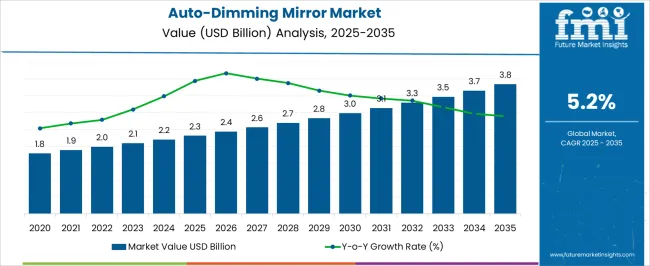
| Metric | Value |
|---|---|
| Auto-Dimming Mirror Market Estimated Value in (2025 E) | USD 2.3 billion |
| Auto-Dimming Mirror Market Forecast Value in (2035 F) | USD 3.8 billion |
| Forecast CAGR (2025 to 2035) | 5.2% |
The auto-dimming mirror market is estimated to hold a notable proportion within its parent markets, representing approximately 8-10% of the automotive mirror market, around 5-6% of the automotive electronics market, close to 4-5% of the vehicle safety systems market, about 2-3% of the automotive lighting market, and roughly 1-2% of the automotive interior components market. Collectively, the cumulative share across these parent segments is observed in the range of 20-26%, reflecting the increasing demand for enhanced driver comfort, safety, and convenience features in modern vehicles.
The market has been driven by the need for mirrors that reduce glare from headlights, offering a safer and more pleasant driving experience at night. Adoption is primarily influenced by the growing focus on vehicle safety features, consumer preference for advanced automotive technologies, and the rising demand for premium car interiors. Market participants have focused on enhancing auto-dimming technology to offer faster response times, improved durability, and enhanced performance across various lighting conditions. As a result, the auto-dimming mirror market has not only captured a significant share of the automotive mirror and electronics markets but has also influenced the vehicle safety, lighting, and interior components markets, underlining its importance in enhancing vehicle safety, driving comfort, and overall user experience.
The auto-dimming mirror market is experiencing steady expansion, supported by rising consumer demand for enhanced safety and comfort features in modern vehicles. Increasing awareness about the hazards of glare from trailing vehicle headlights is driving the adoption of mirrors that automatically adjust brightness to improve driver visibility and reduce eye strain.
Advancements in sensor technology, combined with integration capabilities for features such as compass, temperature display, and driver-assist alerts, are enhancing the value proposition of auto-dimming mirrors. Growth is further supported by regulatory emphasis on road safety and the rising inclusion of advanced driver assistance systems in passenger and commercial vehicles.
The trend toward vehicle electrification and connected technologies is encouraging manufacturers to integrate auto-dimming mirrors as part of a broader smart cockpit system As automotive OEMs continue to prioritize comfort and safety, the market is poised for sustained growth, with expansion expected across both developed and emerging markets driven by increased adoption in mid-range and entry-level vehicle segments.
The auto-dimming mirror market is segmented by product, technology, vehicle, propulsion, distribution channel, and geographic regions. By product, auto-dimming mirror market is divided into Interior rearview mirror and Exterior rearview mirror. In terms of technology, auto-dimming mirror market is classified into Electro chromatic and Non-electro chromatic. Based on vehicle, auto-dimming mirror market is segmented into Passenger cars and Commercial vehicles. By propulsion, auto-dimming mirror market is segmented into ICE and Electric vehicles. By distribution channel, auto-dimming mirror market is segmented into OEM and Aftermarket. Regionally, the auto-dimming mirror industry is classified into North America, Latin America, Western Europe, Eastern Europe, Balkan & Baltic Countries, Russia & Belarus, Central Asia, East Asia, South Asia & Pacific, and the Middle East & Africa.
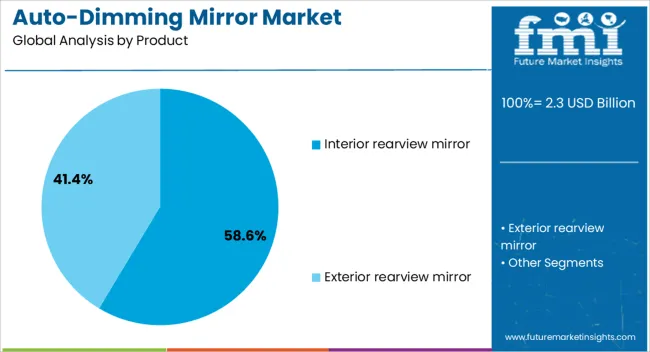
The interior rearview mirror segment is expected to account for 58.6% of the auto-dimming mirror market revenue share in 2025, establishing it as the leading product type. Its dominance is being driven by its central role in improving driver safety by minimizing glare during nighttime driving and adverse weather conditions. Interior rearview mirrors are widely adopted across a broad spectrum of vehicles, from entry-level models to premium offerings, due to their cost-effectiveness and ease of integration.
The growing inclusion of value-added features such as integrated displays, garage door openers, and navigation prompts is enhancing the functional appeal of this product type. OEM partnerships with technology providers are enabling the development of compact and multi-functional units, further supporting adoption.
The segment’s growth is also being fueled by regulatory mandates for improved rear visibility and the rising penetration of ADAS technologies that integrate seamlessly with interior mirror systems This combination of safety benefits, versatility, and compatibility with advanced vehicle systems is expected to sustain the segment’s leadership in the global market.
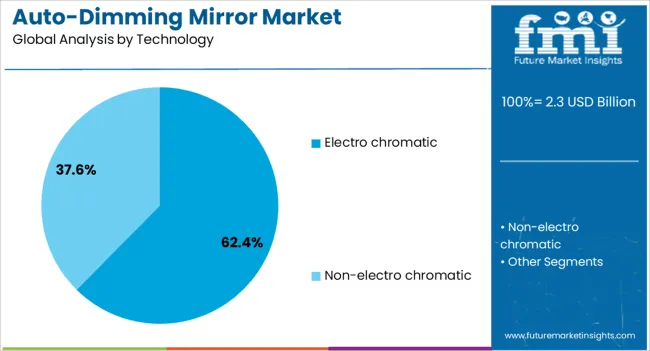
The electro chromatic technology segment is projected to hold 62.4% of the auto-dimming mirror market revenue share in 2025, positioning it as the dominant technology type. Its leadership is supported by its proven ability to provide fast, automatic glare reduction without compromising visibility. Electro chromatic mirrors adjust their reflectivity based on ambient light conditions detected by onboard sensors, delivering optimal performance in varying driving environments.
This technology is increasingly being integrated with additional functionalities such as blind spot detection indicators, turn signal integration, and embedded cameras to enhance driver awareness. The segment is benefitting from advancements in material science and manufacturing processes that have improved durability, response time, and energy efficiency.
OEM adoption is accelerating as the technology offers a premium yet cost-competitive upgrade over manual dimming systems With growing consumer preference for automated comfort and safety features, electro chromatic mirrors are expected to remain the technology of choice for both passenger and commercial vehicle applications in the coming years.
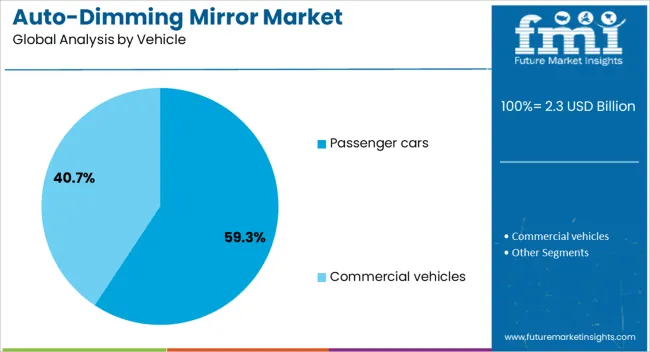
The passenger cars segment is anticipated to capture 59.3% of the auto-dimming mirror market revenue share in 2025, making it the leading vehicle category. This leadership is being driven by the high production volumes of passenger cars globally and the growing incorporation of premium features into mid-tier vehicle models.
Rising consumer demand for enhanced in-cabin comfort and safety, along with heightened awareness of glare-related accident risks, is influencing OEMs to include auto-dimming mirrors as standard or optional features. The segment is also benefiting from the increasing integration of these mirrors with advanced infotainment and driver-assist systems, aligning with trends in connected and semi-autonomous vehicle development.
Strong adoption in markets with high night-time driving frequency and diverse weather conditions is further supporting growth As competition intensifies among automakers to differentiate their offerings, the inclusion of advanced mirror technologies is emerging as a key value proposition, ensuring the continued dominance of the passenger cars segment in the global market.
The auto-dimming mirror market is expanding, driven by increasing consumer demand for safety and comfort features. With safety regulations pushing for higher standards, auto-dimming mirrors are becoming standard in many vehicles. The growing integration of smart features in these mirrors is further shaping the market’s evolution. However, high production costs remain a challenge, especially for mass-market vehicles. As the industry works towards cost-effective solutions, the auto-dimming mirror market is poised for continued growth, meeting both consumer and regulatory needs.
The auto-dimming mirror market is witnessing substantial growth driven by the increasing consumer demand for enhanced comfort and safety in vehicles. Auto-dimming mirrors provide significant benefits by reducing glare from headlights of following vehicles, which improves driving visibility at night. As consumers demand higher levels of comfort and safety features in their vehicles, auto-dimming mirrors have become a key component in modern automotive designs, particularly for high-end cars and luxury segments.
Governments worldwide are tightening vehicle safety standards, which has led to a rise in the adoption of advanced driver assistance systems (ADAS). Auto-dimming mirrors play an essential role in improving safety during nighttime driving, aligning with regulatory requirements. This compliance is expected to boost the demand for auto-dimming mirrors as manufacturers strive to meet evolving safety norms. As regulatory bodies continue to push for safer vehicles, the integration of auto-dimming technology in mass-market models is set to increase.
The latest trends in the auto-dimming mirror market indicate a growing integration of smart features, including inbuilt cameras, sensors, and heads-up displays. These advanced features enhance driver convenience and vehicle aesthetics, offering an innovative driving experience. The shift towards smart mirrors, which provide additional functionalities beyond simple glare reduction, is expected to reshape the market dynamics. As the demand for connected vehicle technologies rises, auto-dimming mirrors with added capabilities will become more widespread.
Despite the growing demand, challenges such as the high production cost of auto-dimming mirrors persist. The technology involved in auto-dimming, including specialized sensors and coatings, requires significant investment in manufacturing processes. These elevated costs impact the overall pricing of vehicles, particularly in budget segments. Although market growth is anticipated, addressing the affordability issue remains critical. Manufacturers are exploring cost-effective production methods to lower prices without compromising on quality, but it remains a significant challenge in the market.
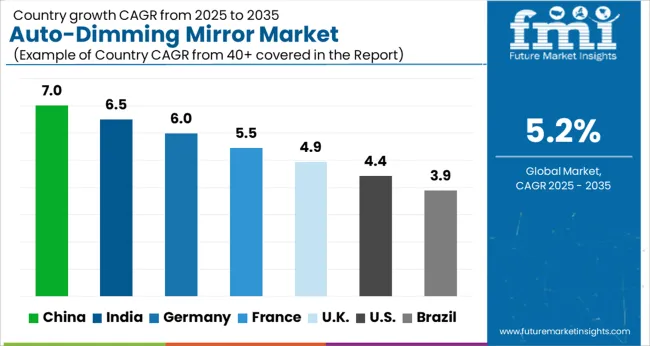
| Country | CAGR |
|---|---|
| China | 7.0% |
| India | 6.5% |
| Germany | 6.0% |
| France | 5.5% |
| UK | 4.9% |
| USA | 4.4% |
| Brazil | 3.9% |
The global auto-dimming mirror market is projected to grow at a CAGR of 5.2% from 2025 to 2035. China leads with a growth rate of 7%, followed by India at 6.5%, and Germany at 6%. The United Kingdom records a growth rate of 4.9%, while the United States shows the slowest growth at 4.4%. This market is driven by rising demand for enhanced vehicle safety and comfort features, such as auto-dimming mirrors, which help reduce glare from headlights, improving driver visibility. Emerging economies like China and India are benefiting from increased vehicle production and rising disposable income, while developed economies focus on advanced vehicle safety features, regulatory support, and consumer preferences for luxury car enhancements. This report includes insights on 40+ countries; the top markets are shown here for reference.
The auto-dimming mirror market in China is growing at a robust rate of 7%. As the world's largest automotive manufacturing hub, China has seen significant expansion in the automotive sector, driving the demand for advanced car safety features, including auto-dimming mirrors. The rising middle class and growing disposable income are increasing the demand for luxury and feature-rich vehicles, thus boosting market growth. Additionally, government regulations promoting vehicle safety standards further encourage the adoption of auto-dimming mirrors in new vehicles. The Chinese government’s emphasis on smart and electric vehicles also contributes to the growing adoption of modern technologies like auto-dimming mirrors.
The auto-dimming mirror market in India is expanding at a growth rate of 6.5%, driven by the increasing automotive production in the country. India’s growing automotive industry, especially in the mid-range to premium vehicle segments, is contributing significantly to the market. As more consumers opt for vehicles with advanced safety and comfort features, the adoption of auto-dimming mirrors is rising. India’s focus on improving road safety standards and the increasing awareness of vehicle features like glare reduction are further propelling the demand. Moreover, with the growing trend of electric and hybrid vehicles in the country, auto-dimming mirrors are being integrated into these vehicles, pushing their market penetration.
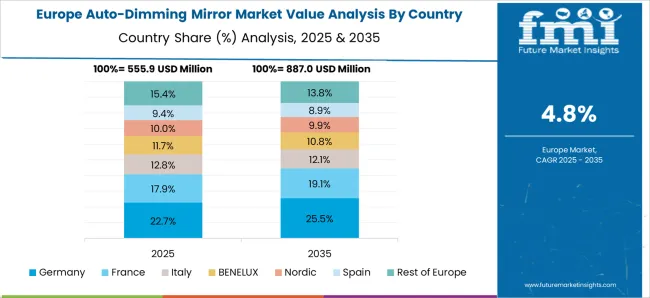
The auto-dimming mirror market in Germany is growing at a rate of 6%, fueled by the country’s strong automotive manufacturing presence, especially in luxury and premium car segments. As a leader in automotive technology, Germany’s automotive industry is continuously innovating, and advanced safety features like auto-dimming mirrors are becoming increasingly standard in both luxury and mid-range vehicles. Regulatory pressure to improve vehicle safety and reduce driver fatigue is also supporting the market for auto-dimming mirrors. German consumers are highly receptive to high-tech automotive features, making the market ideal for the integration of auto-dimming technologies in new vehicles.
The auto-dimming mirror market in the United Kingdom is growing at a rate of 4.9%. While the growth rate is slower compared to other countries, the UK remains a significant market for auto-dimming mirrors due to its well-established automotive industry. The rise in consumer demand for safety and convenience features in both passenger and commercial vehicles is promoting the adoption of these advanced technologies. Furthermore, regulatory initiatives for safer vehicles are encouraging the integration of auto-dimming mirrors in vehicles. In addition, the shift towards electric vehicles in the UK is contributing to the market’s expansion, as manufacturers focus on integrating cutting-edge technologies.
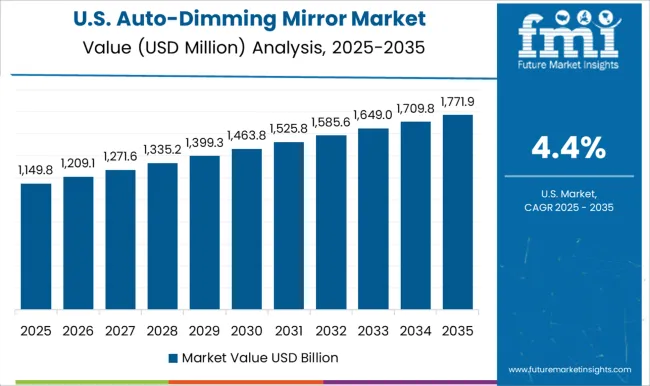
The auto-dimming mirror market in the United States is growing at a rate of 4.4%. As one of the largest automotive markets in the world, the USA is a significant adopter of advanced vehicle safety technologies. The demand for auto-dimming mirrors in the USA is driven by consumer preference for comfort and safety features in both luxury and economy vehicles. The increase in vehicle production, combined with greater awareness of road safety and driver comfort, is boosting the market. Moreover, government regulations and safety standards are encouraging the incorporation of auto-dimming mirrors into vehicles sold in the USA, particularly in high-end models.
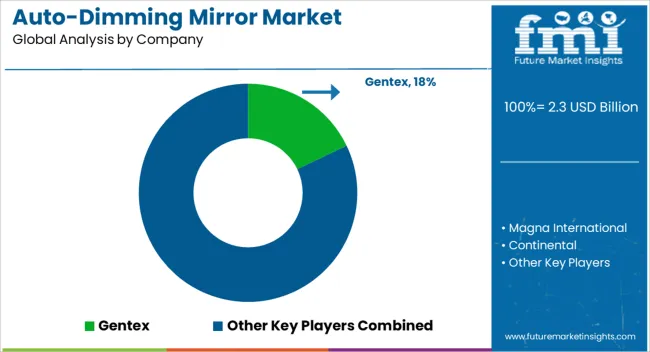
The auto-dimming mirror market has experienced rapid growth, driven by increasing demand for enhanced safety and comfort in modern vehicles. Gentex, a pioneer in the automotive mirror industry, remains a dominant player, offering innovative auto-dimming mirror solutions with advanced features such as integrated HomeLink, temperature sensors, and rain sensors. Magna International and Continental have also made significant strides in this market, providing smart rearview mirrors with adaptive dimming capabilities that improve visibility and reduce glare from the headlights of following vehicles. These mirrors play a crucial role in enhancing driver comfort and reducing eye strain during nighttime driving, thus supporting the growing popularity of smart vehicle technologies.
As consumers demand more advanced and integrated systems, companies like Murakami and Faurecia are focusing on adding cutting-edge functionalities, such as embedded cameras and displays, to their auto-dimming mirrors, thereby expanding the capabilities of this product range. The market is also being driven by growing collaboration and partnerships among automotive OEMs and Tier 1 suppliers. Hella and Ficosa have focused on creating mirrors with innovative dimming technologies that offer enhanced optical performance and energy efficiency.
| Item | Value |
|---|---|
| Quantitative Units | USD 2.3 Billion |
| Product | Interior rearview mirror and Exterior rearview mirror |
| Technology | Electro chromatic and Non-electro chromatic |
| Vehicle | Passenger cars and Commercial vehicles |
| Propulsion | ICE and Electric vehicles |
| Distribution Channel | OEM and Aftermarket |
| Regions Covered | North America, Europe, Asia-Pacific, Latin America, Middle East & Africa |
| Country Covered | United States, Canada, Germany, France, United Kingdom, China, Japan, India, Brazil, South Africa |
| Key Companies Profiled | Gentex, Magna International, Continental, Murakami, Faurecia, Hella, Ficosa, Samvardhana Motherson, Germid, and Konview Electronics |
| Additional Attributes | Dollar sales by mirror type (rearview, side-view) and application (automotive, commercial vehicles, electric vehicles) are key metrics. Trends include rising demand for enhanced driver safety and comfort, growth in electric and autonomous vehicles, and increasing adoption of advanced features like glare reduction and integrated sensors. Regional adoption, technological advancements, and regulatory support are driving market growth. |
The global auto-dimming mirror market is estimated to be valued at USD 2.3 billion in 2025.
The market size for the auto-dimming mirror market is projected to reach USD 3.8 billion by 2035.
The auto-dimming mirror market is expected to grow at a 5.2% CAGR between 2025 and 2035.
The key product types in auto-dimming mirror market are interior rearview mirror and exterior rearview mirror.
In terms of technology, electro chromatic segment to command 62.4% share in the auto-dimming mirror market in 2025.






Our Research Products

The "Full Research Suite" delivers actionable market intel, deep dives on markets or technologies, so clients act faster, cut risk, and unlock growth.

The Leaderboard benchmarks and ranks top vendors, classifying them as Established Leaders, Leading Challengers, or Disruptors & Challengers.

Locates where complements amplify value and substitutes erode it, forecasting net impact by horizon

We deliver granular, decision-grade intel: market sizing, 5-year forecasts, pricing, adoption, usage, revenue, and operational KPIs—plus competitor tracking, regulation, and value chains—across 60 countries broadly.

Spot the shifts before they hit your P&L. We track inflection points, adoption curves, pricing moves, and ecosystem plays to show where demand is heading, why it is changing, and what to do next across high-growth markets and disruptive tech

Real-time reads of user behavior. We track shifting priorities, perceptions of today’s and next-gen services, and provider experience, then pace how fast tech moves from trial to adoption, blending buyer, consumer, and channel inputs with social signals (#WhySwitch, #UX).

Partner with our analyst team to build a custom report designed around your business priorities. From analysing market trends to assessing competitors or crafting bespoke datasets, we tailor insights to your needs.
Supplier Intelligence
Discovery & Profiling
Capacity & Footprint
Performance & Risk
Compliance & Governance
Commercial Readiness
Who Supplies Whom
Scorecards & Shortlists
Playbooks & Docs
Category Intelligence
Definition & Scope
Demand & Use Cases
Cost Drivers
Market Structure
Supply Chain Map
Trade & Policy
Operating Norms
Deliverables
Buyer Intelligence
Account Basics
Spend & Scope
Procurement Model
Vendor Requirements
Terms & Policies
Entry Strategy
Pain Points & Triggers
Outputs
Pricing Analysis
Benchmarks
Trends
Should-Cost
Indexation
Landed Cost
Commercial Terms
Deliverables
Brand Analysis
Positioning & Value Prop
Share & Presence
Customer Evidence
Go-to-Market
Digital & Reputation
Compliance & Trust
KPIs & Gaps
Outputs
Full Research Suite comprises of:
Market outlook & trends analysis
Interviews & case studies
Strategic recommendations
Vendor profiles & capabilities analysis
5-year forecasts
8 regions and 60+ country-level data splits
Market segment data splits
12 months of continuous data updates
DELIVERED AS:
PDF EXCEL ONLINE
Mirror Sheets Market Size and Share Forecast Outlook 2025 to 2035
Mirrored Glass Market
Smart Mirror Market Size and Share Forecast Outlook 2025 to 2035
Safety Mirrors Market - Growth & Forecast 2025 to 2035
Polygon Mirror Scanner Motor Market Size and Share Forecast Outlook 2025 to 2035
Fogless Mirror Market Growth - Trends & Industry Outlook 2025 to 2035
Bathroom Mirror Wiper Market Size and Share Forecast Outlook 2025 to 2035
Fog Free Mirrors Market Size and Share Forecast Outlook 2025 to 2035
Digital Micromirror Device (DMD) market Size and Share Forecast Outlook 2025 to 2035
Smart Fitness Mirror Market Size and Share Forecast Outlook 2025 to 2035
Convex Safety Mirrors Market Growth - Demand & Forecast 2025 to 2035
Automotive Rear View Mirror Market
Telescopic Inspection Mirror Market Size and Share Forecast Outlook 2025 to 2035
Automotive Auto Dimming Mirror Market Size and Share Forecast Outlook 2025 to 2035

Thank you!
You will receive an email from our Business Development Manager. Please be sure to check your SPAM/JUNK folder too.
Chat With
MaRIA